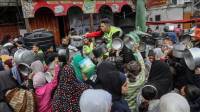

FENI - Wading through muddy floodwaters up to chest height, hundreds of people slowly make their way to safety, their belongings held high above their heads to keep them dry. Entering the city of Feni in southeast Bangladesh, it becomes clear why it is described as the epicenter of one of the country’s worst floods in living memory. Since Wednesday night, water has inundated 11 districts, and large swathes of the city of nearly 1.5 million people are now submerged.
Bangladesh lives on its rivers and waterways, its people relying on the vital life source for fishing and farming rice paddies. The country is also well-acquainted with flooding and cyclones, especially in recent years, as scientists say human-caused climate change exacerbates extreme weather events. But this flood took them by surprise and people here blame officials in India.
Dozens of people CNN met in Feni – which is only a few miles from the India border – accused New Delhi of releasing water from the Dumbur dam in neighboring Tripura state with no warning. As we waded past their homes, some people shouted, “We hate India” and “This is Indian water.” “They opened the gate, but no information was given,” said Shoriful Islam, 29, an IT worker who returned to his hometown from the capital Dhaka to volunteer in rescue efforts. India denied the dam release was deliberate and said excessive rain was a factor, although it conceded that a power outage and communications breakdown meant they failed to issue the usual warning to neighbors downstream.
“India used a water weapon,” Islam said. “India is taking revenge for destroying the last government.” CNN joined two missions run by volunteers to provide relief supplies and rescue vulnerable people in Feni. The only way in or out of the flood zone is by boat, all the main roads are completely cut off to vehicles, and rescue efforts are being slowed by the lack of electricity and near-total communications blackout in the city.
The army and navy have been mobilized to coordinate relief operations and a nationwide volunteering effort has sprung up in the past few days, with people arriving from Dhaka and other parts of the country to lend a hand with rescues and delivering aid. Some of them are also returning to their hometown to search for their family members. Volunteer Abdus Salam, 35, who usually works as an English teacher in Dhaka, said 12 members of his family are stranded in a rural area 15 miles (25 kilometers) from the center of Feni, including his two sisters, brother, and their children. “I don’t know if they are alive,” he told CNN. “I’m crying lots of the time.” “There’s no electricity, no gas, no internet,” he added, calling for the international community to send assistance. Nearly 5 million people are impacted by the floods in Bangladesh, and at least 18 people have been killed, but there are fears that number could rise much higher as the flood waters recede.
In neighboring India, officials say at least 26 people have been killed, and more than 64,000 people are seeking shelter in relief camps in the Tripura region. Anger is now rising among the flood victims in Bangladesh about the source of the water that flooded their homes. Pranay Verma, India’s high commissioner to Bangladesh, told Bangladesh’s interim government an “automatic release” occurred at the dam due to high water levels, according to the interim government’s press secretary, Shafiqul Alam. But some believe politics played a part. “India displayed inhumanity by opening the dam without warning,” said Nahid Islam, one of the two student representatives in Bangladesh’s interim government, headed by Nobel Peace Prize laureate Muhammad Yunus. Three weeks ago, Bangladesh ejected its long-standing Prime Minister Sheikh Hasina after a student-led protest movement against job quotas morphed into a nationwide movement to force her out of power when she ordered a bloody crackdown, killing hundreds of people.
Hasina fled by helicopter to India on August 5, after tens of thousands of people marched on the capital and her residence. During her 15 years in power, Hasina formed strong ties with India and Prime Minister Narendra Modi, who is now serving a rare third term.
After her ouster, reports emerged of reprisal attacks against people viewed as loyal to Hasina’s party – many of them Hindus – which sparked major concern in neighboring Hindu-majority India.
India’s Ministry of External Affairs said in statement Thursday that it was “factually not correct” to blame the flooding on water released from Dumbur dam. It said flooding in Bangladesh was “primarily” due to water flowing from large catchment areas on the Gumti River, downstream from the dam.
“Floods on the common rivers between India and Bangladesh are a shared problem inflicting sufferings to people on both sides, and requires close mutual cooperation towards resolving them,” the statement said. As the diplomatic row builds, rescue teams are working around the clock in the flood zone – where every rescue operation is a huge logistical challenge.
What would usually be a four-hour drive from Dhaka is double that on the gridlocked roads as rescue workers and volunteers try to access the flood region from all over the country. Boats are hard to come by – so many families arrive to retrieve their relatives but then have no way to reach them.
“I’m helpless because I don’t have a boat,” said Yasin Arafat, 24, who came from Dhaka to try to reach his father, mother, grandmother and younger brother. He has heard there are 35 families clinging to a rooftop in his village, including two pregnant women. But it’s a three-hour boat ride from the city and he can’t find a rescue boat to take him there.
“They have no water, no food, and they’re very scared,” he said. “In the last 48 hours, I haven’t had any news.”
Even when people can source a boat, there are sections of the city on higher ground – including the railway track – where the vessels need to carried manually by dozens of volunteers.
The main highway through Feni has now turned into its main waterway – and is being used as the central route for people to make it to dry land.
Some of the people able to walk out are wading through waist- or chest-high muddy water – risking water-borne diseases, snakes or drowning to try to reach safety. For many others in the deepest parts of the flood, it’s impossible to try walking – so they are stranded in villages several kilometers from the city center. Even the boat journey to these areas is risky – navigating through dense trees and marshes risks clogging the engine or hitting underwater obstacles invisible in the murky water.
Our boat passes by a government building being used as a rescue center, where an estimated 500 people are sheltering.
Other multi-story buildings – including a flooded hospital and several schools – are being used as a temporary home for those living in single-story shacks that are now underwater. They are physically safe but lacking food, water and medicine.










